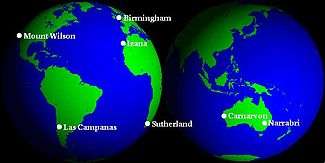Birmingham Solar Oscillations Network

The Birmingham Solar Oscillations Network (BiSON) consists of a network of six remote solar observatories monitoring low-degree solar oscillation modes. It is operated by the High Resolution Optical Spectroscopy group of the School of Physics and Astronomy at the University of Birmingham, UK, in collaboration with Sheffield Hallam University, UK. They are funded by the Science and Technology Facilities Council (STFC).[1]
The BiSON has been collecting data continuously on solar oscillations since 1976, making it the longest running helioseismology network with data covering three solar cycles.[2]
Team
Academic Staff
- Professor Yvonne Elsworth (Head of project)
- Professor Bill Chaplin
Research Staff
- Anne-Marie Broomhall — Helioseismology
- Andrea Miglio
- Steven Hale
Technical Staff
- Mr Ian Barnes — Electronics
- Mr Barry Jackson — Mechanics
Remote observatories
BiSON operates automated resonant scattering spectrometers in astronomical domes or mirror fed systems. The network was established in 1976 with two permanent stations; the addition of several more sites culminated with the addition of a sixth in 1992.[3] The current sites are:
- Mount Wilson Observatory, California, USA
- Las Campanas Observatory, Region IV, Chile
- Observatorio del Teide, Tenerife, Canary Islands, Spain
- South African Astronomical Observatory, Sutherland, South Africa
- OTC Earth Station Carnarvon, Carnarvon, WA, Australia
- Paul Wild Observatory, Narrabri, NSW, Australia
References
- ↑ "BiSON :: Home". Retrieved 2009-05-16.
- ↑ "BiSON The Birmingham Solar-Oscillations Network". Retrieved 2009-05-16.
- ↑ Chaplin, W. J.; Elsworth, Y.; Isaak, G. R.; McLeod, C. P.; Miller, B. A.; New, R. (May 1996). "Recent Results from the Birmingham Solar-Oscillations Network (BiSON)". American Astronomical Society. American Astronomical Society. 188 (1996AAS...188.6904C): 936. Bibcode:1996AAS...188.6904C.